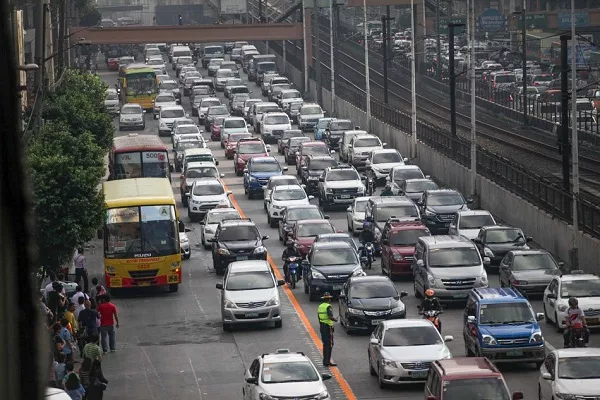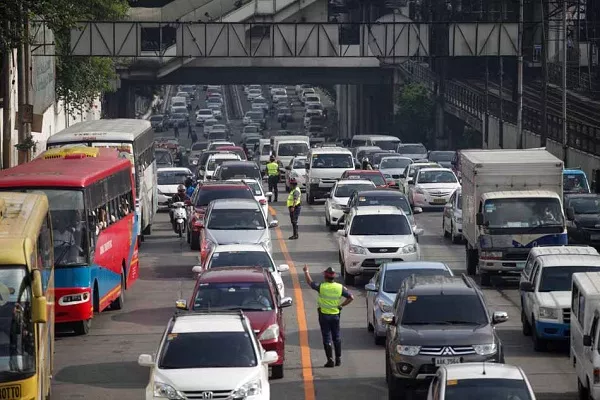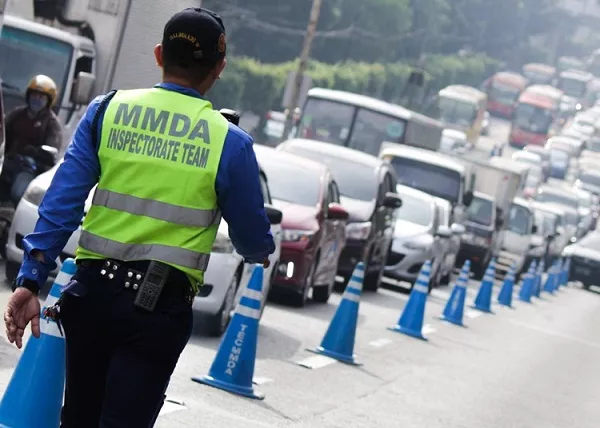Road etiquette and safety are two of the “innate rules” we must follow once we start driving. That is because you can’t directly communicate with your fellow drivers, as well as the people walking on the sidewalks, crossing on pedestrian lanes, and more.
Hence, there are types of roadside signage, driver hand signals, and road markings that you must learn by heart and make sure to follow.
Road markings in the Philippines are either in yellow or white, single or double lanes and continuous or broken. Before getting your driver’s license, you must know what they all mean and of course, remember throughout your driving life.
MMDA’s yellow lane policy is one thing you must understand when you drive around EDSA, whether you are a local in the metro or a tourist. So, read on since Philkotse.com has the right pieces of information for you.

EDSA road with the yellow lane band
1. What is the Yellow Lane Policy?
In general, the yellow lane meaning is defined as the marking to separate traffic is traveling in one or two directions.
Last April 22, 2019, the Metropolitan Manila Development Authority (MMDA), through its official website, informed private and public vehicle drivers that the yellow lane driving policy will be strictly re-implemented. The purpose of this is to ease the traffic congestion in EDSA, especially during the rush hour, as well as have a more systematic traffic flow.
>>> Also check: EDSA Traffic Advisory: Peak hours, Rules, Estimated travel time & more
With that said, let us look into what the yellow lane policy is all about.
Generally, EDSA has three different yellow lane dividers, namely, 1st, 2nd, and 3rd lanes, and based on the policy, city buses are the only ones allowed to traverse the 1st and 2nd (yellow) lanes or the first two lanes near the sidewalk.
On the other hand, private cars and provincial buses should drive within the 3rd lane. That means, they will be apprehended once they enter the yellow lanes except when they need to make a turn.

City Buses Should Stay Within the Yellow Lane
It must be noted, though, that you can only transition once you see the diagonal, broken white lanes, which are approximately 50 meters from an intersection. This, however, also comes with special rules.
One is that you can only merge to the right when you are approximately 12 meters away from the intersection. Secondly, when merging into PUV lanes, you must be within 20 meters from the intersection.
On the contrary, city buses are strictly not allowed to exceed the yellow lane or enter the 3rd lane. In addition to this, they must also unload and load passengers in designated areas and must be done within the 1st lane and never within the 2nd lane.
Apprehension-wise, violators will be fined five hundred pesos. To monitor and catch violators, there are traffic enforcers assigned, as well as CCTV cameras distributed each EDSA lane.

An MMDA Team and CCTV Cameras Will Help Catch Violators
>>> You might like to read: Understand 17 common road markings in the Philippines
2. What are the MMDA yellow lane rules?
The MMDA yellow lane rules took place on November 20, 2019, and according to the MMDA, it was successful since travel time has been lessened by about 30 minutes. Traffic flow on both EDSA southbound and northbound lanes also went smoothly, especially during rush hour. As for the number of apprehensions from morning to afternoon, there were about 500.
TV Patrol: Halos 600 sasakyan, nasampolan sa yellow lane policy sa EDSA
However, such claims were contradicted by passengers or commuters. Some said that they were stuck in traffic longer than usual, which is unfortunate since one of the lanes (3rd) is actually empty. As such, many labeled the policy as an anti-poor ordinance.
Nonetheless, MMDA said that the heavy traffic experienced was due to the confusion on the policy. Also, strict re-implementation has proven that buses are the cause of traffic congestion in the Philippines, backing up their plan to reduce the number of buses in the metro by 50%.
3. Yellow lane policy: Drawbacks
Much like any rules, the yellow lane policy is imperfect; it has its benefits and drawbacks. One party would benefit more than the other. Nevertheless, the implementation of such policies can teach us all how to abide by traffic rules and regulations, which is actually might be the best solution for heavy traffic.
This also helps the officials determine the real problem, as well as paves the way to the creation of more feasible traffic policies.
Recent posts
- RA 10752: The Right of Way Act Philippines: Helpful guide for all Pinoy drivers Nov 17, 2021
- The importance of abiding traffic lights and road signs Aug 16, 2022
- 8 traffic rules and regulations in the Philippines that Pinoy drivers commonly break Aug 16, 2022
- 7 Most Expensive Fines for Traffic Violations in the Philippines (MMDA) Nov 08, 2022
- A Deeper Understanding of the Different Road Signs in the Philippines Apr 24, 2020












